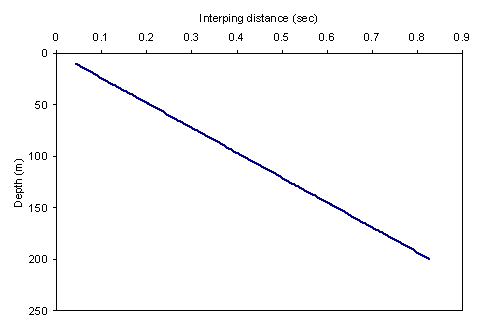Choice of the pulse duration (t), sometimes referred to as pulse length, is dependent on the objectives and conditions of the survey. For higher resolution of individual targets, a shorter pulse duration is desirable, whereas a longer pulse duration is desirable for greater ranges because of a higher signal-to-noise (SNR) ratio. The echosounder must be calibrated at the pulse duration used during a survey. Pulse durations used in the Great Lakes range from 0.2 to 0.6 ms. Most of the standard surveys are done with 0.256 ms (Simrad default) or 0.4 ms (Biosonics default).
Pulse duration is a collection setting and therefore cannot be modified after a survey.
Ping interval
Ping interval determines the rate at which acoustic energy is sent into the water column. In choosing a ping interval, the goal is to select the fastest rate that will not cause shadow bottoms in the data (Fig. 18) and is allowed by the processing speed of the echosounder.. To avoid a shadow bottom originating from the “third” bottom return, the minimum ping interval (i, sec) is:
 |
|
[22] |
where:
BD is the expected maximum water column depth (m), and;
c is the speed of sound in water (m•s-1).
See Ping Interval for example calculations.

Figure 18. Minimum ping interval (s) as a function of depth.
Ping interval is a collection setting and cannot be changed during analysis, although the data can be “resampled” to a slower (but not faster) rate in post-processing software. Ping rates used in the Great Lakes range from 0.25 to 1 ping s
-1. The acquisition software often warns the user of ping rates that are too high, but some may adjust this value without warning (e.g., Simrad EK60).
The echosounder processes the signals, thus depending on the processing speed of the echosounder, the ping interval may need to be set longer than that when only the two-way travel time is accounted for.
The collection of raw data is essential. The raw data depth setting defines how deep data will be collected. If it is set too shallow, data from the bottom of the water column will be missed. Unless better information is available, set the raw data depth to the maximum depth of the lake or the maximum depth with interpretable data.
Raw data depth is a collection value and if set too shallow, data will not be collected beyond that point. In some systems, if the bottom is not detected within the raw data depth, that ping will be lost. If using a system that drops pings when the bottom is not detected, set the raw data depth deeper than the maximum bottom, even if this value exceeds the interpretable data depth.
Setting a file size value determines how large individual data files will be. Simrad and Biosonics data files are based on file size (MB) and Biosonics can also be based on time (minutes). Reasonable file sizes are between 10 MB, or 10-15 minutes. Large file size causes some post-processing software packages to run slowly. More importantly, if there is a file corruption, less data is lost when using a smaller file size. Files can be merged during the analysis.
The depth of the transducer should be measured and recorded on your datasheet. However, for data collection during the survey, set transducer depth to 0. During viewing, all measurements will then be relative to the transducer face. This is an important clarification if the echosounder output is to be used by the vessel captain for bottom sounding. In post-processing software, enter the measured depth to the transducer. When data are exported, depth will then be referenced to the water surface.
Collection thresholds
In Simrad systems, raw data collection does not require the application of a threshold. However, if Simrad telegram data are to be collected, Sv and TS thresholds must be entered. We do recommend collecting raw data, making these thresholds settings less important. For Biosonics systems, one threshold and a threshold model must be selected. To ensure that all data are recorded, enter a threshold that is equivalent to the noise value at 1 m (likely at -120 to -130 dB). However, this will increase the size of the files and a threshold of -100 dB is sufficient for analyzing echoes from mysids shrimps. The threshold should always be low enough to allow for measurement of noise levels on the recorded data. Although the threshold model in Biosonics is not important as long as the threshold is low enough, most Great Lakes users apply the squared threshold model.
In post-processing, thresholds may be set to exclude unwanted echoes. But they cannot be adjusted to include data below the threshold set in the field. Analysis thresholds are discussed in the Data Processing section.
Simrad echosounders includes a bottom ‘backstep,’ used to detect and define the bottom. In rough topography or rough seas, the bottom detection algorithm fails more frequently and bottom echoes will intrude into the water column. The default bottom detection value (-50 dB) is appropriate for most surveys. Biosonics units do not have bottom detection during data collection.
In post-processing, errors in the bottom detection can be manually corrected.
Default settings for single fish recognition are appropriate for viewing during most surveys, but can be modified if more specific detections are desired. Biosonics does not have single fish viewing capabilities during data acquisition. Suggested values for single echo detection parameters are in the Single Echo Detection section.